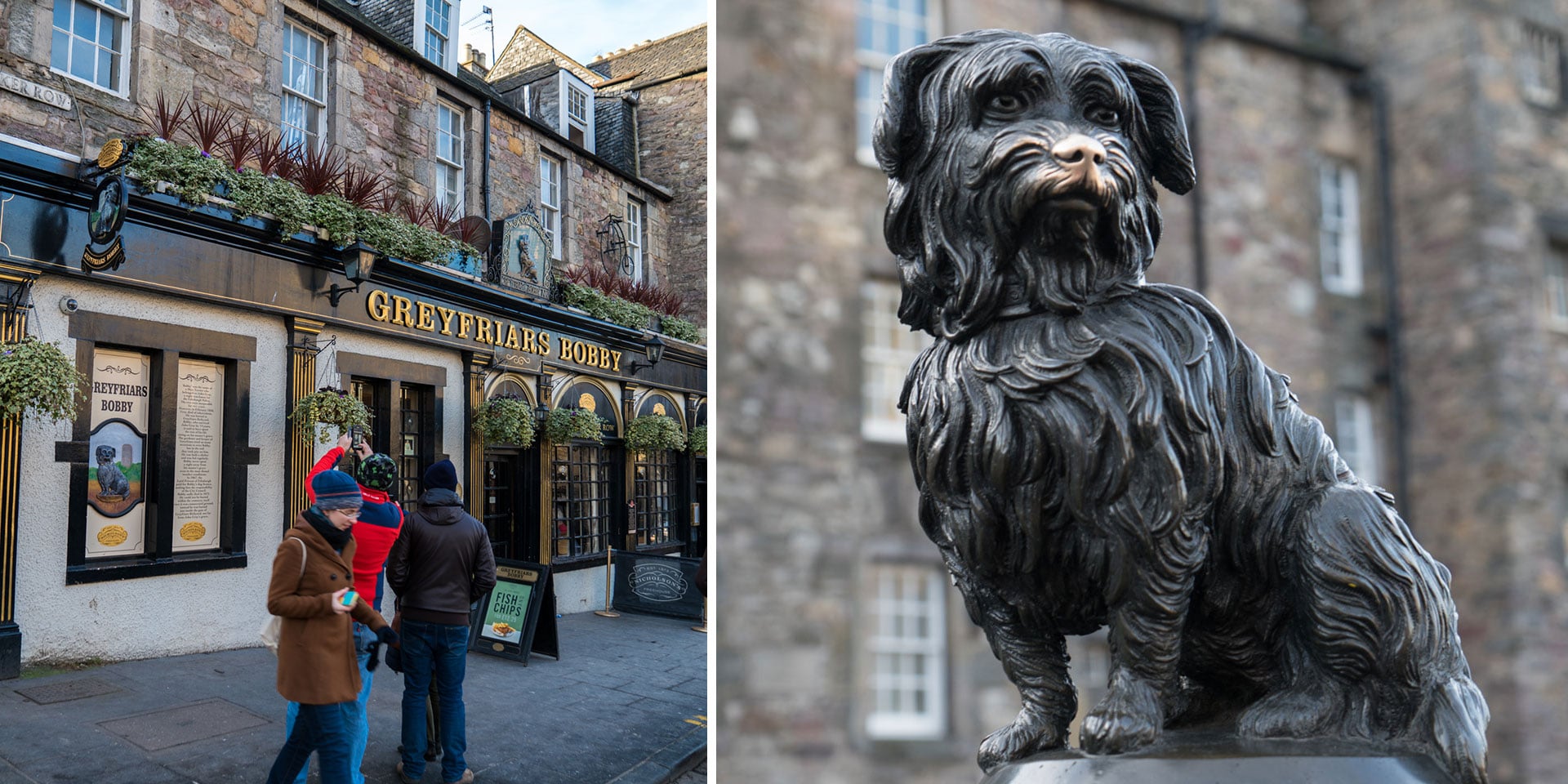As one of the U.K.’s most interesting cities — both from an architectural and a historical point of view — Edinburgh is steeped in an illustrious royal and literary history that spans almost a millennia. Perhaps thanks to this expansive time frame, it also has an equally intriguing dark and twisted past colored by murders, ghosts and mystery.
Due to Edinburgh’s compact size, it is possible to see the best of its glorious and dark history in one day.
Morning
Recall a Sordid History in the Princes Street Gardens
Take some time to walk along the winding paths decorated with colorful flowers and well-manicured plants. Admire the statues and monuments honoring some of Scotland’s most illustrious figures as well as war heroes. And sit on its lawn to take a different view of the iconic Edinburgh Castle. It all sounds pretty, but behind all this beauty, there’s also a dark past.
These gardens used to be an artificial lake, known as Nor’ Loch, built in 1460 to improve Edinburgh Castle’s defenses. When a deadly plague hit Edinburgh in 1645, it’s been said that the Scottish Parliament enacted a rule stating that any parent concealing a child with the plague would be executed either by hanging or drowning in the Nor’ Loch.
The lake, which was more like the city’s cesspool, was also a frequent spot for suicides, so it was also common to see corpses floating in the water. Today there are no visual or physical remains of the lake, but the park’s depressed topography still gives a hint of its former self.
Walk Along the Royal Mile

Cobbled streets, irregular houses, narrow lanes and impressive medieval architecture give this mile-long road a medieval-looking setting not found anywhere else in the world. The Royal Mile stretches from the Edinburgh Castle to Europe’s oldest inhabited palace, the Palace of Holyrood House.
As you walk along the Royal Mile, take some time to appreciate the Gothic grandeur, distinctive crown steeple and ornate interiors of St. Giles Cathedral, originally built in the 14th century as the principal place of worship of the Church of Scotland in Edinburgh.
Also walk along some of the alleys just off the Royal Mile and look up. Back in the Middle Ages, when there was no sewage, people used to pour chamber pots full of human waste out of their bedroom windows with a cry of “Gardyloo!” to warn passersby below.
Today, the well-preserved architecture can help you picture how life could have been back then and how crowded and active the city must have felt.
Look at the Haunted Dungeons at Edinburgh Castle
More a fortress than a castle, this 12th-century complex is perched atop an extinct volcano and dominates the city’s skyline with its monumental military architecture and ornate buildings.
While the entire castle is worth a visit, if you’re short on time, be sure to visit the following: tiny, 12th-century St. Margaret’s Chapel, the oldest building in Edinburgh; the Great Hall, with its 16th-century hammer-beam roof; and the Royal Palace, where the Honours of Scotland are displayed.
The Honours, which are the Scottish crown jewels, are among the oldest surviving crown jewels in Europe and have been used for the coronations of kings for hundreds of years.
You can also take a “haunted” tour of the castle’s dungeons, which once imprisoned the Duke Alexander Stewart of Albany, who’s infamous for escaping, stabbing his guards to death and then burning their bodies.
You’ll also see the cells of Lady Janet Douglas of Glamis, who was accused of witchcraft and burned at the stake, and an unnamed piper famous for wandering down one of the castle’s underground passages, never to return.
Afternoon
Visit Bobby at the Greyfriars Cemetery

Often described as the most haunted cemetery in the world, Greyfriars is the setting for a number of spooky tales. The cemetery’s smooth hills are not as natural as they seem. In fact, in past centuries, the hills were formed by several layers of corpses buried atop each other. Due to its thin topsoil, it is common for a few bones to pop out of their graves now and then.
Surprisingly, the most famous and haunted grave there doesn’t belong to a human. It’s the final resting spot of a Skye Terrier named Bobby, who faithfully watched his owner’s grave for 14 years until he passed away. The devoted pup was buried near his owner’s grave, and today visitors claim to hear barking coming from … beyond.
On your visit, follow the tradition of picking up a stick in the cemetery and placing it on top of Bobby’s grave. Visitors to the grave once thought rubbing Bobby’s nose would bring good luck, but today the tradition is frowned upon and locals prefer you leave Bobby be.
Also, if you’re a Harry Potter fan, visit the Thomas Riddle gravestone, which inspired J.K. Rowling to create Voldemort’s character.
Have a Drink at Maggie Dickson’s Pub and See the Grassmarket
The Grassmarket square was once the site of public hangings a few centuries ago. Peer around the area and you’ll notice one of the most iconic pubs in the city — Maggie Dickson’s — which overlooks the old scene of executions and is named for one of Edinburgh’s more tenacious residents.
Back in 1723, Mrs. Dickson worked for an innkeeper in exchange for lodging. That same year, she had an affair with the innkeeper’s son and became pregnant. To avoid losing her job, she kept the pregnancy secret until her premature delivery. The baby died just a few days later, so Maggie, still hiding her pregnancy, left its body on the riverbank.
The baby’s remains were discovered and traced back to Maggie, leading to criminal charges under the Concealment of Pregnancy Act. She was executed in public in the Grassmarket in 1724, where she was immediately pronounced dead and put in a coffin. On the way to the cemetery, loud bangs from within the coffin prompted her funeral cortege to open the lid, only to discover her still very much alive.
Under Scots Law, she already served her sentence and was legally dead, so she couldn’t be hanged again. From that moment she became known as “Half Hangit” Maggie, and it is said that she attended most public hangings to yell at the sentenced, “Ah, it’s not as bad as you think!”

Evening
Take a Ghost Tour of the Underground City
Underneath its medieval, cobblestone streets, Edinburgh hides an even darker past.
Tours like the Underground City of the Dead take you into the legendary underground city where you’ll discover its scary and often miserable history as you walk the dark tunnels that, for over two centuries, served as shelter to the city’s poorest citizens, as well as thieves, criminals and the unfortunate souls who became sick during the plague.
Also referred to as Damnation Alley, the 19 chambers that comprise the alley are said to be stalked by a malevolent presence known as the South Bridge Entity, which apparently has a thing for spooking people who stand in certain areas of the tunnels — women in particular.
Alternatively, the City of the Dead Haunted Graveyard Tour gives you access to Edinburgh’s Covenanters’ Prison and the Black Mausoleum at Greyfriars, which is said to be haunted by the famous Mackenzie Poltergeist. Sir George Mackenzie committed a bloody religious persecution in the 17th century, torturing and killing Presbyterian covenanters who refused to convert to the state-approved religion.
This is said to be the most documented poltergeist in the world, and even tourists claim to have encountered it.
Dare to go back to the cemetery at night? Who knows whose ghost you’ll see there!




